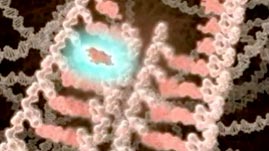Teachers' Domain - Digital Media for the Classroom and Professional Development
User: Preview

Source: Secret of Life: "Immortal Thread"
This silent animation from Secret of Life: "Immortal Thread" presents a detailed look at what happens during DNA replication. The animation demonstrates three processes: replication, wherein DNA strands unwind and separate from one another and each strand's nucleotide sequence is copied; base pairing, wherein nucleotide bases are matched with their counterparts (As with Ts, Cs with Gs) and bound together like the rungs of a ladder; and mutation, wherein a base pair is mismatched and the faulty DNA sequence may be incorporated into a gene.
Whether it is a microbe, a rose, or a dolphin, any form of life gets its building and operating instructions from the molecule of life, DNA. DNA comprises the genes and chromosomes that govern the development of an individual organism. Coiled inside the nucleus of the cell, DNA stores all the information needed in reproducing that individual.
The information of life is packaged in genes, the units of heredity, which are distributed along the chromosomes of an organism. A human being has roughly 20,000 genes—far fewer than scientists believed when the first draft of the human genome was published in 2001. Each gene contains a coded instruction for making a single protein. The chemical code in which the information is written is stunningly simple, consisting of only four different chemical bases, or nucleotides: adenine (A), thymine (T), cytosine (C), and guanine (G). But various combinations of those four bases—for example, A A C G G A C T T A and so on, for thousands of "letters"—can spell out the recipes for tens of thousands of different proteins.
In manufacturing the proteins it needs, the cell uses the gene sequence as a blueprint. A different nucleic acid molecule, known as messenger RNA, makes a copy of the gene sequence and carries it outside the nucleus. The message encoded in the messenger RNA is read by structures called ribosomes, which assemble the protein out of amino acids in the cell's cytoplasm. Each amino acid is specified by a combination of three of the chemical bases (the A, T, C, and Gs), and the amino acids are put together in a long chain to form the protein. The cell then uses the protein or sends it out of the cell to perform some job for the body.
When a cell divides, it makes a copy of its DNA instructions for the new cell. This is represented in the first sequence of the animation. The twisted double-strand structure—the famed double helix—unwinds, and the strands separate. The nucleotides (A, T, C, and G) on each strand pair up with free nucleotides in the nucleus, creating two new strands. (Two enzymes, DNA helicase and DNA polymerase, are responsible for catalyzing the separation and pairing reactions.) Normally, as the second sequence shows, only G can pair with C, and only T can pair with A. Therefore, the order of nucleotides in the original strand specifies the order in the new strand. After each of the old strands is copied in this way, there are two new double-helix molecules, each one containing one strand it inherited from the original molecule and one newly formed strand.
Approximately once every 100,000,000 bases, this copying process makes errors, so that the wrong nucleotide is placed in position. These errors are called mutations. The cell corrects many of the mutations itself. After replication, a group of specialized repair proteins scan the DNA for mismatched bases. When they find a mutation, these proteins remove the incorrect nucleotide and give DNA polymerase a chance to correct the sequence. However, some mutations inevitably get through. Whether these mutations are advantageous, neutral, or harmful to an organism depends on the genes affected and their related cellular functions.
To watch a narrated version of this animation, check out How DNA Replicates.
To learn about the techniques used to sequence DNA and just what scientists can learn by doing it, check out Human Genome Project.
To learn more about mutations are their effects in the body, check out A Mutation Story, How Cancer Grows, and One Wrong Letter.
This background essay has been adapted from Evolution: Library: The Nuts and Bolts of DNA Replication.
 Loading Standards
Loading Standards Teachers' Domain is proud to be a Pathways portal to the National Science Digital Library.
Teachers' Domain is proud to be a Pathways portal to the National Science Digital Library.
